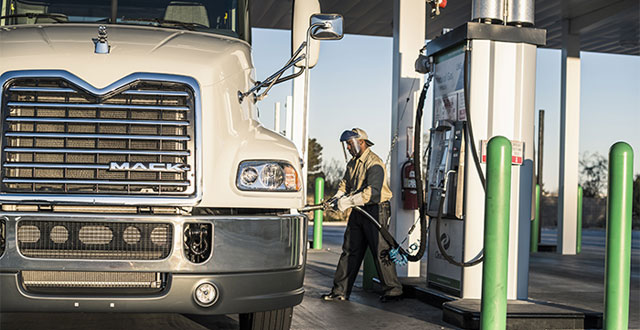While advances in passenger car systems may steal most of the spotlight when it comes to active safety, the trucking segment is also making strides. In particular, new synergies have been found between active safety, connectivity and fuel efficiency.
The idea behind truck automation is to relieve drivers of at least some elements of the job, which can be complex, dangerous or downright boring. However, research has found that there is also an opportunity to save money, an important factor for an industry that is all about efficiency.
Keeping a fleet of 80,000lb (36,300kg) trucks running is expensive, and requires a significant amount of fuel. This is not helped by the fact that a typical diesel Class 8 truck averages single figure miles per gallon. According to the American Transportation Research Institute, fuel accounts for between 30% and 40% of a carrier’s total costs. Whilst initially developed to improve road safety, the likes of adaptive cruise control and vehicle-to-everything (V2X) connectivity could potentially reduce those figures.
Predictive energy management
That’s according to engineering consultancy AVL, which believes fuel expenses could fall not only for traditional diesel and natural gas trucks, but also those with a hydrogen fuel cell or battery electric powertrain.
“Total cost of ownership (TCO) and fuel efficiency are particularly important for a commercial vehicle, be it a battery electric or diesel truck. Being able to improve its driving range and save fuel is vital,” explained Stephen Jones, Principal Product Manager, Systems Engineering at AVL during a recent Automotive World webinar. ADAS and V2X, he says, can help trucks to plan more efficient routes and better prepare for fuel-sapping hill climbs.

Beneath the umbrella term of ADAS falls ‘advanced predictive functions’, which can give trucks an idea of the road ahead, be it traffic conditions, weather or gradient. While this will improve safety – the truck will be able to slow in advance of heavy traffic, for example – energy management will also improve. “Through what we call the ‘connected powertrain,’ this information tells us how the vehicle can be expected to drive in the future, particularly in relation to its speed and load,” explained Jones.
Rather than reacting to traffic lights and roadworks as they come, trucks will be able to prepare in advance. Speed and braking can be better managed in order to avoid highly inefficient stop-start procedures, and the truck will better utilise its own momentum when ascending steep hills and slowing for tight corners. Predictive adaptive cruise control (ACC), for example, can allow a truck to do just that. Connected functions can also be leveraged for ‘eco routing’ – directing the truck to the most fuel efficient roads.
If you fail to plan…
If a fully loaded truck is in the wrong gear, it can spell disaster for average fuel economy figures. Predictive gear shifting could prove particularly important for heavy-duty CVs, which can have anywhere between nine and 18 gears. Looking ahead to automated trucking, it may even be vital.
In future, platooning or indeed driverless trucks could approach a hill and change gear mid-gradient, causing a significant loss in speed and momentum. The powertrain would then need to react, drop down a few gears, and make that speed back up – a highly inefficient operation. As Jones puts it: “The biggest impact to energy efficiency is the velocity of the vehicle.” By allowing the powertrain to select the right gear at the right time through connectivity, this dip in momentum at a critical point can be avoided altogether.
But in order for these functions to work, how accurate does the underlying real-time data need to be? Gradient data is notoriously inaccurate, for example, and in theory could mean that the truck under or over prepares for a hill. However, Jones explained that errors in altitude profile would only cause a slight dip in the performance of the system.

“Because we are looking at energy efficiency and not automated driving, the requirements for the accuracy of map data are lower,” he said. “If we were trying to optimise the speed of a CV over gradients of 150 metres and have an error rate of 5% to 10%, it will effect the benefit of our system, but not negate it.”
Improving powertrain efficiency by leveraging safety technologies: it is a seemingly tenuous link. However, the automotive industry as a whole is also pushing for greater cost efficiency, and Jones expects more solutions to come out of existing technologies. “In the world of ADAS and connectivity today, we have lots of features and functions coming from different providers. This is very difficult to manage and develop,” he concluded. “There is now a tendency to try to develop features and functionalities that do several things, and a general desire to simplify and combine architectures.”



